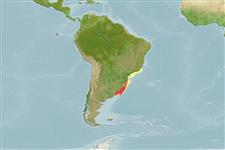Common names from other countries
Environment: milieu / climate zone / depth range / distribution range
Ecologia
marinhas demersal. Subtropical; 9°S - 37°S
Southwest Atlantic: southern Brazil to southern Argentina.
Tamanho / Peso / Idade
Maturity: Lm ? range ? - ? cm
Max length : 60.0 cm TL macho/indeterminado; (Ref. ); common length : 40.0 cm TL macho/indeterminado; (Ref. 6077)
Descrição breve
Chaves de identificação | Morfologia | Morfometria
Espinhos dorsais (total) : 5 - 6; Raios dorsais moles (total) : 33; Espinhos anais: 3; Raios anais moles: 33 - 41; Vértebras: 27. First dorsal fin composed of several short spines preceded by an anteriorly directed spine usually completely embedded under skin. Two detached anal spines anterior to soft anal fin. Lateral line curved and undulated, with more or less 10 branches anteriorly and fairly straight posteriorly (Ref. 27363). A black patch on the opercle is a conspicuous character of this species, thus the name signata (Ref. 3157).
Maximum length assumed to be 1.5 * 40 = 60 cm TL (RF).
Life cycle and mating behavior
Maturities | Reprodução | Spawnings | Egg(s) | Fecundities | Larvas
Robins, C.R., R.M. Bailey, C.E. Bond, J.R. Brooker, E.A. Lachner, R.N. Lea and W.B. Scott, 1991. World fishes important to North Americans. Exclusive of species from the continental waters of the United States and Canada. Am. Fish. Soc. Spec. Publ. (21):243 p. (Ref. 4537)
Categoria na Lista Vermelha da IUCN (Ref. 130435)
CITES (Ref. 128078)
Not Evaluated
Ameaça para o homem
Harmless
Utilização humana
Pescarias: pouco comercial
Ferramentas
Relatórios especiais
Descarregue XML
Fontes da internet
Estimates based on models
Preferred temperature (Ref.
115969): 11.3 - 22, mean 19.3 (based on 75 cells).
Phylogenetic diversity index (Ref.
82804): PD
50 = 1.0000 [Uniqueness, from 0.5 = low to 2.0 = high].
Bayesian length-weight: a=0.01047 (0.00482 - 0.02276), b=2.92 (2.74 - 3.10), in cm Total Length, based on LWR estimates for this (Sub)family-body shape (Ref.
93245).
Nível Trófico (Ref.
69278): 3.4 ±0.45 se; based on food items.
Resiliência (Ref.
120179): Médio, tempo mínimo de duplicação da população 1,4 - 4,4 anos (Assuming tm>=2).
Fishing Vulnerability (Ref.
59153): Moderate vulnerability (44 of 100).
Climate Vulnerability (Ref.
125649): High to very high vulnerability (75 of 100).
